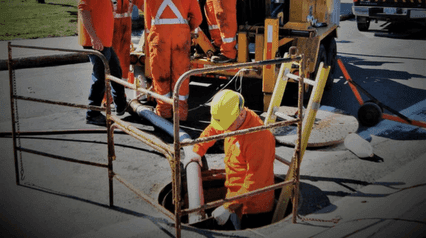What is Confined Space Safety?
Confined space safety is the practice of ensuring safe work conditions in fully or partially enclosed areas such as manholes, pipelines, boilers, utility vaults, and storage bins. Confined space safety precautions should be undertaken accordingly to comply with health and safety regulations and prevent work-related injuries, illnesses, or even deaths.

What is Confined Space?
According to the U.S. Occupational Safety and Health Administration (OSHA), a confined space is an area large enough to fully enter or perform certain jobs. A confined space also has limited or restricted means of entry or exit and is not designed for continuous occupancy. Apart from the OSHA criteria, confined spaces are defined across countries or regions as follows:
NIOSH Confined Space
Based on the definition of the National Institute for Occupational Safety and Health (NIOSH), a confined space refers to a space that, by design, has limited openings for entry and exit, unfavorable natural ventilation which could contain or produce dangerous air contaminants, and is not intended for continuous worker occupancy.
While OSHA enforces regulations, NIOSH provides research-based recommendations to prevent work-related injuries. Therefore, it is empirical that NIOSH includes the element of “unfavorable natural ventilation” in its definition of a confined space.
HSE Confined Space
As the regulator of occupational health and safety legislation in the U.K, the Health and Safety Executive (HSE) explains that a confined space is a place which is substantially enclosed (though not always entirely), and where serious injury can occur from substances or conditions within the space or nearby (e.g., lack of oxygen).
While OSHA and NIOSH specify that a confined space is not designed or intended for continuous worker occupancy, the HSE emphasizes that a confined space safety does not only include substances or conditions within the area but also nearby or around it.
CCOHS Confined Space
The Canadian Centre for Occupational Health and Safety (CCOHS) elaborates that a confined space is a fully or partially enclosed area that is not primarily designed for continuous human occupancy and has limited or restricted entrance or exit, or a configuration that can complicate first aid, rescue, evacuation, or other emergency response activities.
WorkSafeBC Confined Space
As a statutory agency based in the Canadian province of British Columbia, WorkSafeBC simply states that a confined space is an enclosed or partially enclosed area that is big enough for a worker to enter.
Safe Work Australia Confined Space
According to the definition of Safe Work Australia (SWA), a confined space is determined by the hazards associated with the specific situation—not just because work is performed in a small space. SWA stresses that hazards in a confined space are not always obvious and may change from one entry point to the next.
Importance
Statistics show that an average of 90 people die each year while working in confined spaces in the United States alone. Most of these incidents are caused by asphyxiation or oxygen deficiency due to the presence of deadly gases while performing certain jobs. Detailed safety procedures must be thoroughly conducted to ensure all entrants will be provided adequate protection while performing their jobs inside the confined space.
What is a Permit-Required Confined Space?
A permit-required confined space also known as a “permit space” contains or has the potential to contain a hazardous atmosphere or any other serious safety or health hazards. Permit-required confined spaces are characterized as high-risk workplaces, requiring regulatory permits and strict entry and safety procedures.
What are the Oxygen Levels in Confined Spaces?
Outside the confined space, 21 percent oxygen is necessary to sustain life. Oxygen in confined spaces tends to go low. If oxygen is reduced to 12 to 16 percent, workers will increase pulse and respiration and experience loss of coordination. If the oxygen decreases to 6 to 10 percent, they will experience nausea, vomiting, loss of consciousness, and even death.
OSHA Standard and Requirements
OSHA 1910.146 is the standard for confined spaces. The OSHA confined space standard explains the requirements for permit-required confined spaces in detail. Generally, listed below are some OSHA confined space requirements:
- Evaluate the workplace to determine if any spaces are permit-required confined spaces.
- Inform exposed employees if the workplace contains permit spaces.
- Take effective measures to prevent employees from entering the permit spaces if employers decide that employees will not enter permit spaces.
- Develop and implement a written permit space program if employers decide that employees will enter permit spaces.
- Use alternate procedures for entering a permit space under certain conditions.
- When there are changes in the use or configuration of a non-permit confined space that might increase the hazards to entrants, reevaluate that space and, if necessary, reclassify it as a permit-required confined space.
- A space classified by the employer as a permit-required confined space may be reclassified as a non-permit confined space under specific procedures.
- When an employer (host employer) arranges to have employees of another employer (contractor) perform work that involves permit space entry, the host employer should follow the established protocol.
- Each contractor who is retained to perform permit space entry operations should adhere to the given process.
Improve your EHS Management
Cultivate a safe working environment and streamline compliance with our EHS solutions.
Explore nowWhat is a Rescue Plan in Confined Space Safety?
A confined space rescue plan is a system of steps undertaken by designated personnel to rescue employees from permit spaces. The OSHA requirements related to a confined space rescue plan are as follows:
- Develop and implement procedures for summoning rescue and emergency services, for rescuing entrants from permit spaces, for providing necessary emergency services to rescued employees, and for preventing unauthorized personnel from attempting a rescue.
- Evaluate a prospective rescuer’s ability to respond to a rescue summons promptly, considering the hazard(s) identified.
- Evaluate a prospective rescue service’s ability, in terms of proficiency with rescue-related tasks and equipment, to function appropriately while rescuing entrants from the particular permit space or types of permit spaces identified.
- Select a rescue team or service from those evaluated.
- Inform each rescue team or service of the hazards they may confront when called on to perform a rescue at the site.
- Provide the rescue team or service selected with access to all permit spaces from which rescue may be necessary so that the rescue service can develop appropriate plans and practices for operations.
- Provide affected employees with the personal protective equipment (PPE) needed to safely conduct permit space rescues and train them so they are proficient in the use of PPEs.
- Train affected employees to perform assigned rescue duties and basic first-aid and cardiopulmonary resuscitation (CPR).
- Ensure involved employees practice permit space rescues at least once every 12 months.
- To facilitate non-entry rescue, retrieval systems or methods shall be used whenever an authorized entrant enters a permit space, unless the retrieval equipment would increase the overall risk of entry or would not contribute to the rescue of the entrant.
- If an injured entrant is exposed to a substance for which a Material Safety Data Sheet (MSDS) or other similar written information is required to be kept at the worksite, that written information shall be made available to the medical facility treating the exposed entrant.
Create your own Confined Space Safety checklist
Build from scratch or choose from our collection of free, ready-to-download, and customizable templates.
Browse Confined Space Safety checklistsFAQs About Confined Space Safety
The following items are some precautions to observe to ensure safety in confined spaces:
- Provide proper training and certification for all workers entering the confined space
- Perform a hazard assessment or regular inspection of the space before entry
- Monitor air quality and ensure adequate ventilation
- Use appropriate PPEs such as respirators, gloves, and safety harnesses
- Secure communication with workers inside and outside the confined space and have a worker on standby outside at all times
- Implement lockout/tagout procedures to prevent accidental activation of equipment or machinery
- Establish emergency response and rescue plan procedures and make sure that all workers are aware of them
The main hazard when working in a confined space is the deadly atmosphere due to the presence of carbon monoxide, hydrogen sulfide, and methane gas which may result in oxygen deficiency or asphyxiation. Other common confined space hazards include unguarded machinery, exposed live wires, and heat stress.
PPEs for confined spaces include respiratory protection items such as self-contained breathing apparatus (SCBA) and air-purifying respirators, Protective clothing such as coveralls, chemical-resistant suits, gloves, hard hats, and boots are also necessary. Eye and face protective gear should also be worn, which includes safety glasses and goggles. For hearing protection, earmuffs and earplugs are recommended.
Confined spaces include tanks, vaults, pits, manholes, tunnels, equipment housings, pipelines, boilers, furnaces, compactors, sewers, attic spaces, and elevator pits. Common work performed in confined spaces includes maintenance, inspection, repair, and cleaning.




